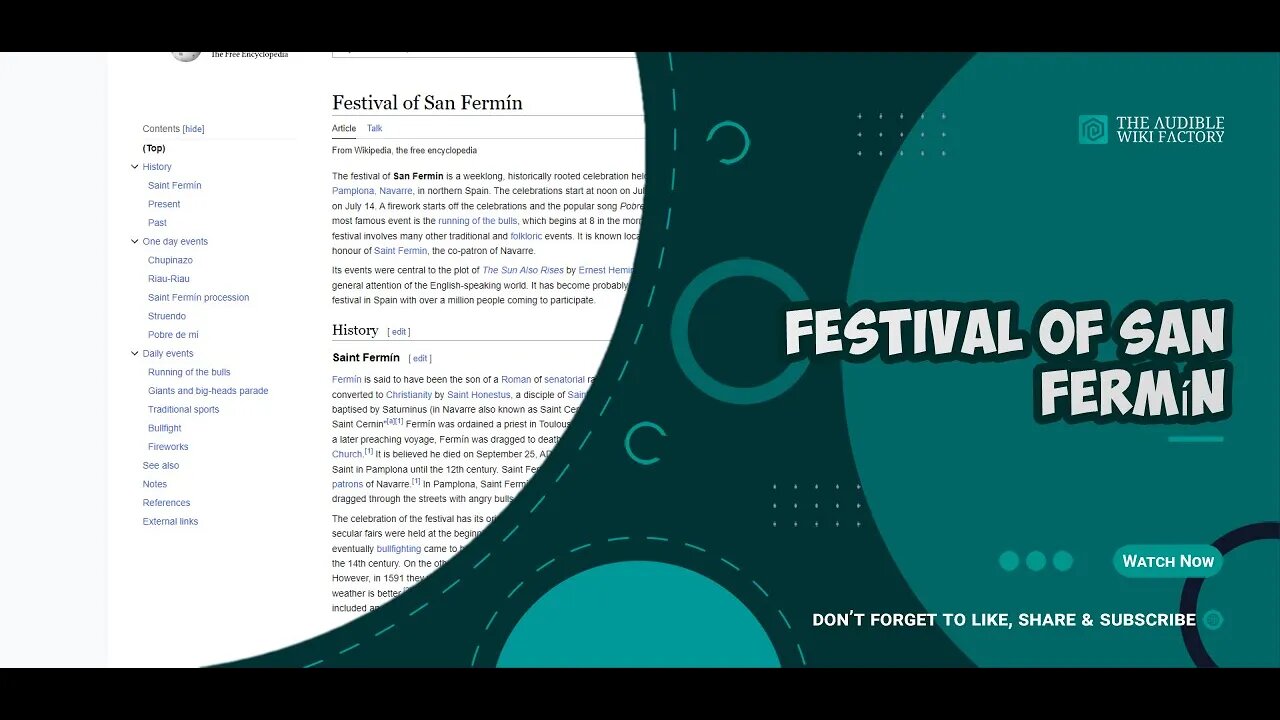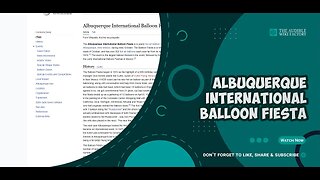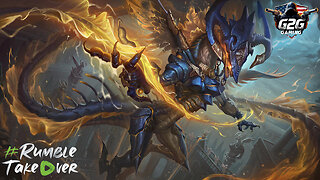Premium Only Content

The festival of San Fermín is a weeklong, historically rooted celebration held annually in the
The festival of San Fermín is a weeklong, historically rooted celebration held annually in the city of Pamplona, Navarre, in northern Spain. The celebrations start at noon on July 6 and continue until midnight on July 14. A firework starts off the celebrations and the popular song Pobre de mí is sung at the end. The most famous event is the running of the bulls, which begins at 8 in the morning from July 7 to 14, but the festival involves many other traditional and folkloric events. It is known locally as Sanfermines and is held in honour of Saint Fermin, the co-patron of Navarre.
Its events were central to the plot of The Sun Also Rises by Ernest Hemingway, which brought it to the general attention of the English-speaking world. It has become probably the most internationally renowned festival in Spain with over a million people coming to participate.
HISTORY
SAINT FERMÍN
Fermín is said to have been the son of a Roman of senatorial rank in Pamplona in the 3rd century, who was converted to Christianity by Saint Honestus, a disciple of Saint Saturninus. According to tradition, he was baptised by Saturninus (in Navarre also known as Saint Cernin) at the spot now known as the "Small Well of Saint Cernin" Fermín was ordained a priest in Toulouse, and returned to Pamplona as its first bishop. On a later preaching voyage, Fermín was dragged to death; and is now considered a martyr in the Catholic Church. It is believed he died on September 25, AD 303. There is no written record of veneration of the Saint in Pamplona until the 12th century. Saint Fermín, as well as Saint Francis Xavier, are now the two patrons of Navarre. In Pamplona, Saint Fermín is now sometimes said to have met his end by being dragged through the streets with angry bulls running after him, hence the tradition.
The celebration of the festival has its origin in the combination of two different medieval events. Commercial secular fairs were held at the beginning of the summer. As cattle merchants came into town with their animals, eventually bullfighting came to be organised as a part of the tradition. Specifically, they were first documented in the 14th century. On the other hand, religious ceremonies honouring the saint were held on October 10. However, in 1591 they were transferred to July 7 to take place at the same time as the fair, when Pamplona's weather is better. This is considered to be the beginning of the Sanfermines. During medieval times acts included an opening speech, musicians, tournaments, theatre, bullfights, dances or even fireworks. Bullrunning appears in 17th and 18th century chronicles together with the presence of foreigners and the first concerns about the excessive drinking and dissolute behaviour during the event. Finally, the Parade of Giants was created in the mid-19th century. The first official bullring was constructed in 1844.
LINK TO ARTICLE: http://en.wikipedia.org/wiki/Festival_of_San_Fermín
TAGS: Festival of San Fermín, Tourist attractions in Navarre, Navarre culture, July events, Patronal festivals in Spain
#GeneralKnowledge #AudibleWikiFactory #Audible #Wikipedia #FestivalofSanFermín
-
 9:22
9:22
The Audible Wiki Factory
1 year agoThe Albuquerque International Balloon Fiesta is a yearly hot air balloon festival that takes
705 -
 LIVE
LIVE
TheAlecLaceShow
3 hours agoHunter Biden Pardoned | Who’s Next? | Kash Only | Racism | Guest: Franck Zanu | The Alec Lace Show
154 watching -
 LIVE
LIVE
G2G Gaming Channel
6 hours agoI heard Smite, So Im here! #RumbleTakeOver #RumbleGaming
168 watching -
 15:36
15:36
Neil McCoy-Ward
1 hour ago🚨 Emergency Martial Law Declared, Special Forces Deployed...
12.7K4 -
 LIVE
LIVE
The Charlie Kirk Show
1 hour agoDemocrat Billionaires in Crisis + Fixing the Migrant Crisis | Blagojevich, O'Brien, Metaxas| 12.3.24
7,969 watching -
 1:01:07
1:01:07
The Dan Bongino Show
4 hours agoBiden’s Reign Of Destruction Isn’t Over Yet (Ep. 2381) - 12/03/2024
611K1.32K -
 1:59:02
1:59:02
Steven Crowder
4 hours ago🔴 COVID Chronicles: The Hidden Truths of the Pandemic Exposed
336K189 -
 LIVE
LIVE
SoundBoardLord
3 hours agoMulti-Gen Don Juan in Full Force!
217 watching -
 1:08:54
1:08:54
MTNTOUGH Fitness Lab
3 hours agoSheriff Mark Lamb Exposes America’s Border Crisis and Cartel Infiltration | MTNT POD#93
8.75K1 -
 8:52
8:52
Cooking with Gruel
12 hours agoToasted Brown Butter Cornbread
10.8K